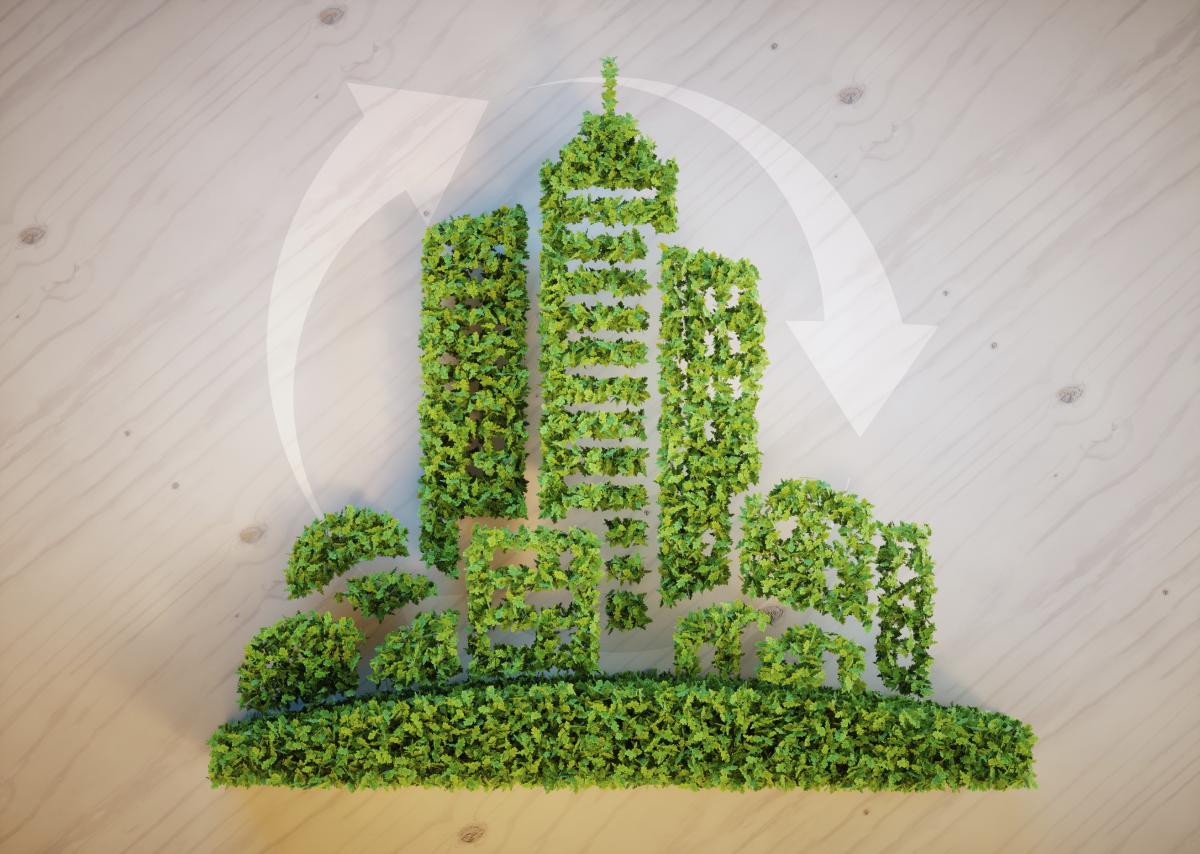Innovations such as 3D printing mean the construction sector can play an important role in the circular economy
Instead of thinking about building high, construction companies should be thinking about building round – that is, in accordance with circular economy principles.
Leading voices, including the UK’s Green Construction Board and the European Construction Industry Federation (FIEC), argue that circular economy approaches such as resource efficiency, durability, maximising the value of resources and designing out waste will be critical to making the construction industry more sustainable.
The sector in the UK consumes around 400m tonnes of materials each year. According to the Department for Environment Food & Rural Affairs the industry is also responsible for roughly 100m tonnes of waste – half of the national total.
Not only would circular economy practices benefit the industry, by making it more efficient, but in turn the industry is critical to the circular economy because of its role in designing (and redesigning) the built environments of tomorrow, its proponents argue.

"The construction industry has a key role in making the circular economy a reality," says FIEC. It calls for a greater acceptance of the use of recycled materials in construction projects, and says the use of new technologies and tools, along with clearer regulations around the classification of waste, could provide a huge boost for the circular economy in construction. It highlights building material manufacturers as having a vital role.
At a recent event organised by sustainability alliance the Aldersgate Group in London, Mat Roberts, director of sustainability at construction services firm Interserve, highlighted the importance of the circular economy in efforts by his company to hit a 50% carbon reduction target by 2020. He said the process of demolition on a building site had evolved to one of “decommissioning and dismantling”.
Proponents point out the many opportunities that the circular economy could bring to the construction sector, including improving the residual value of buildings and their components, improving resource and supply chain security, and improving performance for the end user.
Yet they also acknowledge that circular economy thinking has to go beyond just recycling materials and reducing waste, to giving these materials greater value over the course of their lifecycles and reimagining the very concept of waste.
For example, recycling rates in the construction industry are already high: in the UK around 87% of non-hazardous construction and demolition waste was recovered in 2012 (as opposed to going to landfill), well ahead of an EU target for 70% by 2020. However, much of the value of this “waste” is lost even after recycling, and this can weaken the incentives for manufacturers and suppliers to spend time, effort and money designing these materials for reuse.
Nitesh Magdani, director of sustainability at BAM Construct UK, says that for this reason, despite some early success stories involving entire buildings designed and constructed with “circular” principles in mind, convincing suppliers to embrace the circular economy more fully and take more long-term responsibility for the materials they manufacture and provide has proven a significant challenge.
Part of this stems from the problem that the circular economy industry is still quite "high-end", Magdani says. To help overcome this, BAM has begun running a series of workshops to encourage more suppliers and clients to understand the implications of moving to more circular economic business models, and of applying these principles to the design, construction and maintenance of built environment assets. Magdani says it is easier to communicate the concept to suppliers in group sessions than on a one-to-one basis. "It also helps us to understand the circular economy not just from our perspective, but from our suppliers' perspective as well," he says.
Innovation
Ambitions to extend the lifecycle of building materials and make them easier to reuse and recycle are far from new, but they are being given traction by advances in technology. The most important is widely touted to be Building Information Modelling, or BIM. It is essentially a digital platform that allows designers, contractors, and manufacturers to create a virtual 3D model of a planned building, and can be used to simulate how that building will perform under different scenarios of material composition, or with minute alterations in the design of components. BIM also involves the collection of vast quantities of data on the physical properties of materials including, crucially, their performance on key sustainability metrics such as its carbon footprint or durability.
Among the greatest benefits that BIM can bring to building owners is the potential to track exactly what goes into a building, which makes it easier to deconstruct and recover materials at the end of the building's life. This could go a long way towards allowing those materials to retain their value in a subsequent usage.

It can also, according to Magdani, be an enabler of emerging concepts such as design for manufacture and assembly (DfMA), modular building or even 3D printing. These methods, by allowing designers to map out exactly what resources they need and what shape individual components should be, can help to reduce the amount of construction waste generated onsite, something that accounts for as much as 15% of all construction-related waste. Magdani says contractors “need to work closer with [their] clients to ensure that [they] are not just reducing waste through construction, but also increasing the productivity of materials during a building’s first and subsequent use cycles.”
Magdani also sees BIM as a vehicle that allows more stakeholders – including suppliers and planning consultants – to get involved in the design process. By encouraging more collaboration from this earlier stage, it makes it easier for various value chain partners to tackle common challenges around designing for sustainability, he says.
Industry sources point to 3D printing as another technological advance that could have a lasting impact, as new ways of designing components digitally and printing them in intricate detail allow designers a degree of flexibility and experimentation that would be hard using traditional construction methods.
Importantly, 3D printing can also allow the building of parts and individual structures with little or no waste, as materials are printed in the exact shape required and don't need to be cut out of larger blocks of material. The “ink”, or filament, that is printed into new components can be composed of low-grade construction waste materials such as pulverised concrete or sand, or even a mix of other basic recycled content such as plastics. Not only does this give new value to basic materials that might otherwise struggle to find a suitable industrial purpose, but it also means that any printed products can be just as easily ground back down into filament to be reprinted as another design, thus ensuring a continuous loop of inputs and outputs.
Examples of innovative buildings constructed using 3D printing include a six-storey "mansion" built in China by local engineering firm WinSun and the new temporary headquarters for the EU presidency in Amsterdam, partly built using 3D-printed material designed by DUS Architects. BAM has also worked on projects in the Netherlands with individual 3D-printed components, Magdani says.

However, there are question marks over how feasible these technologies are for everyday construction firms, and whether they can be scaled up to the point where entire towns and cities can be 3D-printed. Magdani and others think it is more likely that 3D printing will transform the way that individual components of buildings are designed and manufactured.
Despite the apparently clear benefits of BIM, take-up of these tools across the industry has been slow, and there is a sense that construction companies have yet to learn how to make the most of the opportunities offered by BIM and other new technologies.
"Some clients seem to just want BIM for BIM's sake," Magdani says. "They've heard it's a good tool, but don't really understand how to fully utilise it, or they don't yet appreciate how transformational it could be to the whole design and construction process." The main benefit of BIM is to enable buildings to operate more efficiently, he says, suggesting that contractors who are well-versed in its application should address this issue with potential clients and ask them, "What do you want [BIM] for, and how do you envisage using the data generated by your building?"
Development imperatives
While the construction industry has a big role to play in mitigating CO2 emissions, it also has a responsibility to make buildings that can withstand the extreme impacts of a changing global environment – something that is recognised in UN Sustainable Development Goal nine: “Build resilient infrastructure, promote sustainable industrialisation and foster innovation”.
Luiz Gabriel Todt de Azevedo, sustainability director at Construtora Norberto Odebrecht, the Brazilian construction and industrial giant, says dealing with issues such as climate change and global development represents not just a cos” for construction and engineering firms but also an opportunity for them to innovate in the areas of transportation, water supply, energy-generation and resilience against climate change and extreme weather.

The Paris agreement resulting from the COP21 summit in December has added value to the work companies have already done to monitor their carbon footprint, Azevedo says, and provides a stronger framework to encourage them to go further. "[It] provides the certainty and confidence for businesses to take significant steps," he says.
Odebrecht is also innovating in how it treats the local communities where it works in the global south, setting up projects that contribute to local socio-economic development, such as inviting local people, not just workers on a construction site, to classes where they can learn computer skills.
Azevedo says Odebrecht's charter requires it to share any "wealth" – in terms of opportunities and value created – with wider society. Such projects also help it to engage with the communities who will be the principal users of its products.
In the end, though, any ambitions contractors may have to contribute to sustainable development goals or mitigate CO2 emissions must still be squared with meeting the requirements of their clients.
Lily Crompton, director of construction sustainability consultancy LJ Sustainability, says: "If the client hasn't expressed any interest around adaptation or resilience to climate change, contractors can rarely afford to factor in sustainability considerations regardless." But if a company is able to showcase an innovative development, for example in climate resilience, she adds, it can raise the bar across the industry.
innovations green construction sustainability economy resource efficiency Environment waste reduction development water supply energy COP21

